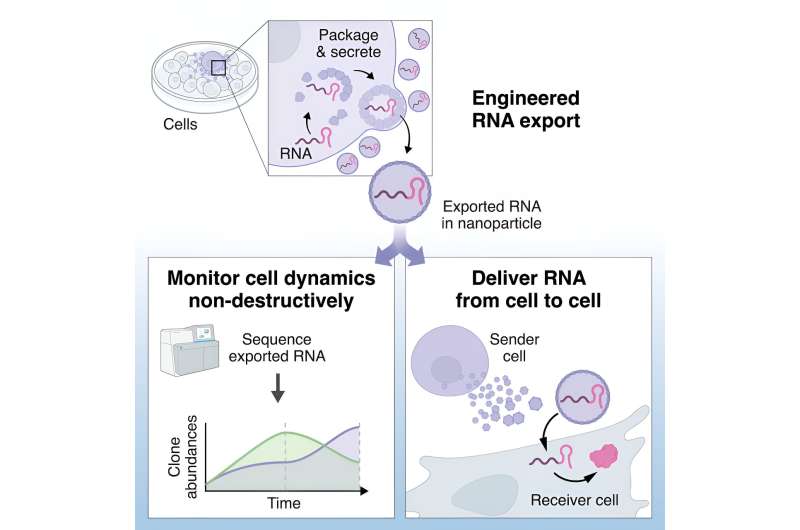This article has been reviewed according to Science X's editorial process and policies. Editors have highlighted the following attributes while ensuring the content's credibility:
fact-checked
peer-reviewed publication
trusted source
proofread
A synthetic RNA export system reveals the dynamic lives of cells and suggests direction for new therapeutics

Cells change dynamically over time during embryonic development and aging, and in diseases such as inflammation and cancer. Some populations expand, others decline. The ability to track these changes over time, without killing the cells being measured, would provide powerful insights into many processes.
RNA molecules, which serve as the instructions for making the proteins the cell uses for its various functions, can give precise clues into what is going on inside of cells. However, current state-of-the-art technologies for surveying RNA requires killing the cell: breaking it open in order to collect and analyze all of the molecules inside. This means that researchers can only capture a snapshot of the state of the cell the instant before it died rather than being able to watch how it develops and changes over time.
"Reading" the RNA in a cell is a useful way to study biological processes, but actually tinkering with or "writing" the RNA within a cell is a powerful tool to influence cellular behavior and therefore treat disease. For example, several vaccines for COVID-19 work by delivering messenger RNA (mRNA) into a cell and thus inducing the production of antibodies against the virus. RNA could be a useful means to address diverse diseases, but delivering it into the right cells has been challenging.
Now, Caltech researchers have developed a single system that addresses both challenges in "reading" and "writing" RNA. The new technology allows scientists to study the RNA in cells over time without destroying them, providing a new way to follow myriad cellular processes from embryonic development to cancer. Remarkably, the same system also enables programming cells to deliver RNA to other cells, opening up the possibilities of engineering cellular behaviors in specific ways and potentially allowing new therapeutic strategies.
"There are many processes in biology where we want to know how cells change over time," says postdoctoral scholar Felix Horns, the study's first author. "For example, during development, the embryo develops into many different tissues by changing cellular states. Numerous diseases like cancer are processes that unfold over time, and, of course, aging also occurs through changes over time as well.
"RNA plays the central role of telling the cell what to do," Horns adds. "If we can measure the RNA that a cell is expressing, that allows us to read what it's doing. Additionally, as we've all seen in the last few years in the form of RNA vaccines, we can put instructions into a cell and program what it does by delivering mRNA."
"The amazing thing is that the same molecular device—our RNA export system—addresses the two seemingly independent challenges of readout and control," says Michael Elowitz, professor of biology and bioengineering and Howard Hughes Medical Institute Investigator.
The research was conducted primarily in the Elowitz laboratory and is a collaboration with the laboratories of two additional Caltech faculty: Pamela Bjorkman, the David Baltimore Professor of Biology and Biological Engineering and Merkin Institute Professor; and Carlos Lois, research professor of biology. A paper describing the study appeared in the journal Cell.
The new system, dubbed COURIER (Controlled Output and Uptake of RNA for Interrogation, Expression, and Regulation), enables RNA export from cells. With COURIER, one can genetically engineer a cell to package some of its own RNA in little self-assembling protein containers and then "ship" (or secrete) it out in a membrane-bound vesicle.
For example, researchers could program the boxes to package a certain type of RNA that is a signature of disease, or a specific "cellular identification card" to tell researchers what cell they are looking at. Alternatively, they could program the boxes to encapsulate a sampling of all RNA present in a cell, giving a snapshot of what the cell is doing more broadly.
Either way, the little packages of RNA leave the cell, enabling researchers to collect and analyze evidence of the cell's inner workings without disrupting it. In this way, researchers can use COURIER and exported RNA to track how populations of cells change over time during dynamic processes such as cancer or embryonic development.
The second category of applications for COURIER is in delivering therapeutics. After being exported from the cell, the protein container can dock with another cell and deliver RNA into it. That cell can then express proteins encoded by the RNA, which can be designed for a variety of functions: editing the genome, changing the state of the cell, or killing it if it is in a diseased state.
Currently, mRNA vaccines for COVID-19 operate similarly, delivering mRNA that encode for fragments of the SARS-CoV-2 virus and subsequently inducing the production of antibodies. mRNA delivery could allow for a range of different types of medicines in addition to vaccines. However, a key challenge has been how to deliver mRNA to the relevant cell types.
"Living cells could, in principle, operate as programmable mRNA delivery vehicles that bring therapeutic mRNA to the right cells in the right places in the body," says Elowitz. "To achieve that vision, we need a way to export specific mRNAs in a format that can be taken up and expressed by other cells. That is what this system provides. COURIER allows one cell to produce mRNA and then encapsulate it in particles that deliver it to other cells, which then express it."
More information: Felix Horns et al, Engineering RNA export for measurement and manipulation of living cells, Cell (2023). DOI: 10.1016/j.cell.2023.06.013
Journal information: Cell
Provided by California Institute of Technology





















